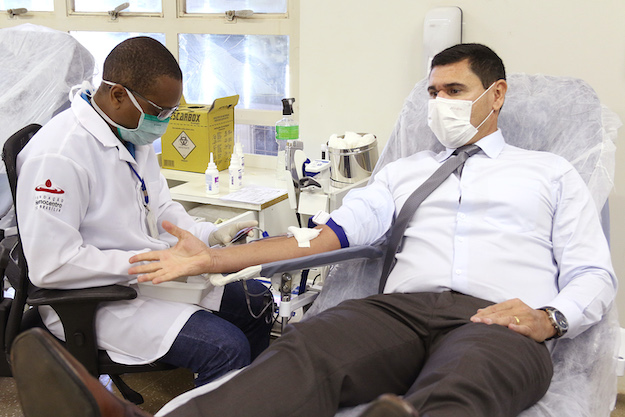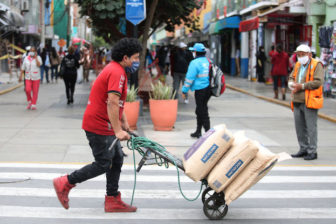This article is adapted from AQ’s special report on fighting the effects of the COVID-19 pandemic. See all 5 Big Ideas for recovery here:
Guarantee Income | A New Trade Push | Universal Health Care
Not Just GDP | Keep Kids in School
RIO DE JANEIRO — What if, following the pandemic shock, all Latin American countries heavily increased investments to build robust, comprehensive and universal health care systems?
As COVID-19 continues to wreak havoc, by late May Brazil had surpassed the United States in having the world’s highest daily death rate related to the virus. As a result, one may not think of Brazil as an inspiration for public health policies at the moment. However, the Brazilian experience shows that building a strong public health care service on a continental scale is not only possible, but highly effective to improve the health of citizens, particularly those in more vulnerable situations.
Download our 5 Big Ideas special report as a PDF
Indeed, the pandemic highlighted how important it was for Brazil to have one of the most comprehensive health care systems in the developing world. Inspired by the British National Health Services, the Unified Health System (known as SUS, for its initials in Portuguese) is a key feature of the 1988 Constitution, drafted following the end of military rule in 1985. Brazil is the only country in the world with a population of more than 100 million to have a universal health care system.
The SUS notwithstanding, the federal government’s response to COVID-19 could not have been worse — the president himself famously called it “nothing but a little flu,” opposed social distancing measures, advocated distributing drugs with no proven effect, and encouraged people to form rallies and agglomerations. There was no national strategy to deal with the crisis. As a result, the decentralized approach of the SUS has been activated endogenously by state and municipal governments and is managing to provide at least some response to the crisis.
COVID-19 was at first considered a leveler, but it quickly became clear that the most disadvantaged groups were being more severely affected, as was true in much of the world. Without the SUS, the 78% of the population that does not have private insurance would not have had proper access to health services during the pandemic.
For the past 30 years, the SUS has led to an impressive improvement of key health indicators in Brazil: Infant mortality declined from 53 to 14 per thousand, life expectancy increased from 64 years to almost 76 years, and racial inequalities in health decreased. The SUS’s Family Health Strategy is the largest community-based primary care program in the world, now covering around 60% of the Brazilian population. Every year, the SUS covers more than 2 million births, 10 million hospital admissions, and nearly 1 billion outpatient procedures — free of charge for anyone in Brazil.
Moreover, Brazil has an excellent track record on vaccination coverage (96% of the population is vaccinated against BCG, diphtheria, polio and hepatitis), tobacco control (down to 13.1%, one of the lowest rates in the world) and HIV containment. Thanks to the SUS, Brazil ranks 22 of 195 nations in the 2019 Global Health Security Index.
The system’s architecture mirrors Brazil’s federal structure: Municipalities are responsible for primary health care, state governments for more complex health services, and the federal government for coordinating the whole system and partially funding local health programs. This decentralized structure generates uneven coverage, since resource availability and management skills vary tremendously across local governments. For example, a recent study by the Institute for Health Policy Studies (IEPS) revealed that more than half (56%) of the population lives in regions where the number of ICU beds is below what is considered adequate, and more than 10% of the population lives in areas where there are no ICU beds at all.
The somewhat arbitrary split of tasks between state and local governments is a source of inefficiency, particularly as it relates to the availability, scale and location of hospitals (often too small and underutilized).
The system is also chronically underfunded and tainted by corruption. Moreover, and surprisingly, 30 years after its birth, the SUS consumes only 3.8% of Brazil’s GDP. The public sector covers three-quarters of the population with less than half the total health care spending, a lower percentage than in the United States. There are substantial constraints to access to free public health care as well as quality issues in the provision of health services.
Without the SUS, the 78% of the population that does not have private insurance would not have had proper access to health services during the pandemic.
The supply of health care is not sufficient to fully tackle Brazil’s extremely intricate burden of disease, as it combines the prevalence of non-communicable diseases (a characteristic of developed countries) with infectious diseases (which are endemic in many developing countries) and external causes (accidents and homicides, typical in many Latin American countries). Thus, it has to address a wide array of ailments, from hypertension and diabetes to dengue fever and Zika, requiring extremely diverse health and policy solutions.
The COVID-19 test
Amid the pandemic, and despite structural limitations and inequalities, Brazil is building field hospitals and expanding the number of ICU beds. It is also providing monetary assistance to about a third of the population. However, health professionals are scarce in Brazil. As a consequence, some brand-new facilities lack personnel. In fact, another study conducted by IEPS shows that, should the infection rate surpass 4% of the population, most states in the North and Northeast regions will face a severe shortage of doctors. Above an 8.7% rate, all states will be in the same situation, with the exception of the federal district where the cutoff rate is 14.3%. Moreover, due to the lack of protective gear, death rates among health care professionals is quite high.
In some regions, expanding health care infrastructure may not be enough to avoid hospital collapse if the COVID-19 curve is not flattened in time. It has been particularly difficult to implement social distancing policies in a country as vast and unequal as Brazil, where a third of the population lives in households with a per capita income of $100 per month. Millions of Brazilians are informal workers, often invisible to government aid policies. This is also the reality in most of Brazil’s densely populated cities, and yet many have managed to achieve some success in minimizing the crisis as income transfers have made their way to the poor and the demand for hospital care has been met by hospital capacity.
While Argentina, Colombia, Paraguay and Uruguay have implemented restrictive policies, including lockdowns, Brazil has chosen much softer directives. Fortunately, many governors and mayors have implemented stricter restrictions in their jurisdictions, and recent evidence indeed indicates that these measures have helped reduce Brazil’s contagion rate from 3.5 to 1.4, still a high number. Civil society and community leaders have also played a decisive role in many instances — for example, cancelling the famous funk block-parties in Rio de Janeiro’s favelas.
However, the uncoordinated nature of these policies is troubling. Some cities have closed down all storefronts except for essential activities, others have barely implemented any policies at all. The greatest portion of the blame for this glaring lack of coordination lies with the federal government, which has failed to provide an overall strategy to deal with the crisis.
The SUS’ politics and economics
President Jair Bolsonaro himself continues to fan the flames of political instability. He is the only world leader to have fired two health ministers in the middle of the crisis. Bracing himself for an economic disaster, Bolsonaro is banking on framing the terrible economic performance on the state governments’ response to the new coronavirus.
The president is pushing for the reopening of businesses, showing immense disregard for the more exposed segments of the population. Brazil finds itself lodged between a rock and a very hard place, as any relaxation of quarantine policies will mean a greater risk of the systemic collapse of health care services, with dire consequences, particularly to vulnerable populations.
Brazil clearly needs to strengthen its health care system, expanding its staff of health professionals — especially primary care doctors and nurses — as well as investing in facilities and better management practices. It cannot depend too much on imported strategic health products such as tests, so far a glaring major gap in the effort to fight the pandemic. A study conducted by IEPS forecasts that health spending in Brazil will need to increase by nearly four percentage points of GDP by 2060 to cover the health care needs of its fast-aging society.
This is a major challenge as public-sector finances in Brazil are in precarious shape. The consolidated budget has been in the red since 2014 and debt is now fast approaching 100% of GDP. Moreover, 80% of government spending goes into social security and payroll, a number that makes Brazil a total outlier among its peers. It should not come as a surprise that government investment has declined from a peak of 5.4% of GDP 50 years ago to less than 1% estimated for this year. Deep reforms are required if Brazil is to mobilize the resources necessary to move away from the long-dated and sad situation of unequal and unsustainable stagnation.
Health spending in Brazil will need to increase by nearly four percentage points of GDP by 2060 to cover the health care needs of its fast-aging society.
Needless to say, health care reform should also be based on institutional rearrangements that could improve the productivity and quality of the services. A good example are the opportunities for efficiency gains that would arise from better coordination between local primary care and state hospital services. The success of some states in subcontracting private management of hospitals suggests this is an area that must be further studied and explored. Moreover, particularly in big cities, primary care and preventive measures should be consolidated. Finally, there is plenty of room for leapfrogging through the use of technology, both basic (individual and collective data) and advanced (telemedicine).
Brazil’s current health policy debate is deeply polarized, and the result is a classic stalemate. When SUS advocates hear that more efficiency is needed, they think, “Here come more cuts.” When SUS critics hear that more budget resources are needed, they think, “More efficiency is the answer.” Our conclusion is simple: Both sides are right.
The pandemics have revived the importance of universal health care systems. In spite of being a social right in almost every nation of Latin America, health care has not been prioritized in terms of public funding and this must change. With all its structural flaws and underfunding, the SUS has proven to be an affordable provider of widespread health care coverage and a promoter of social equity. Therefore, in spite of the terrible example set by Brazil’s federal government during this crisis, the SUS is still a model to be followed by other countries.
—
Fraga is the chair of the Institute for Health Policy Studies (IEPS) and a former president of Brazil’s central bank. Lago is the executive director of the Institute for Health Policy Studies (IEPS). Rocha is the head of research of the Institute for Health Policy Studies (IEPS) and associate professor at Fundação Getúlio Vargas.







